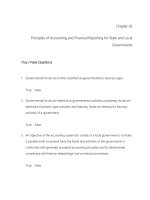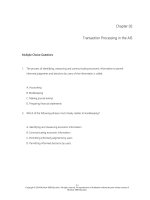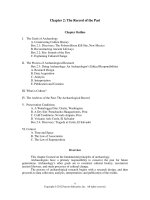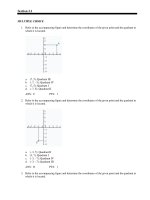Organizational behavior key concepts skills and best practices 5th edition kinicki test bank
Bạn đang xem bản rút gọn của tài liệu. Xem và tải ngay bản đầy đủ của tài liệu tại đây (427.38 KB, 122 trang )
Chapter 02
Organizational Culture, Socialization, and Mentoring
True / False Questions
1. Organizational culture is passed on to new employees through the process of
socialization.
True
False
2. Organizational culture influences the type of organizational structure adopted by a
company.
True
False
3. Espoused values represent the explicitly stated values and norms that are preferred
by an organization.
True
False
4. The company bulletin board on which employees post notes is an example of an
enacted value.
True
False
5. Since a gap between espoused values and enacted values has no influence on
employee attitudes and organizational performance, managers should not waste
time on reducing such gaps.
True
False
6. When basic assumptions are widely held among employees, people will find
behavior based on an inconsistent value easier to follow.
True
False
7. Changes in organizational culture occur rapidly at the level of basic assumptions
and only gradually at the level of observable artifacts.
True
False
8. Giving members an organizational identity is one of the functions of organizational
culture.
True
False
9. The competing values framework (CVF) provides a practical way for managers to
understand, measure, and improve profitability.
True
False
10. Organizations can possess characteristics associated with more than one culture
type.
True
False
11. An organization cannot have both a clan culture and a hierarchical culture.
True
False
12. The basic method by which a clan culture achieves effectiveness is collaboration.
True
False
13. An organization with an external focus that values flexibility has a hierarchical
culture.
True
False
14. An adhocracy culture values flexibility and has an external focus.
True
False
15. A market culture is well suited for companies that rule the market and have no
competitors.
True
False
16. Organizations with a market culture tend to reward people who deliver results.
True
False
17. The clan culture and market culture are both represented by values that emphasize
an internal focus.
True
False
18. An organization's culture can be a source of competitive advantage.
True
False
19. The process of organizational change always begins with the recruitment of new
employees.
True
False
20. Organizational culture will not change in a significant way unless managers are
able to change basic underlying assumptions.
True
False
21. The anticipatory socialization phase begins when the employment contract has
been signed.
True
False
22. Organization socialization begins before the individual actually joins the
organization.
True
False
23. Divestiture is the denial and stripping away of the newcomer's existing sense of self
and the reconstruction of self in the organization's image.
True
False
24. Serial socialization provides a timetable for the assumption of the role, whereas a
variable process does not.
True
False
25. Clothing company Beetle Basics puts all its new employees through the same
three-day orientation program. This is a collective, formal socialization experience.
True
False
26. A disjunctive socialization process is one in which the newcomer is socialized by an
experienced member.
True
False
27. Formal socialization is the practice of segregating a newcomer from regular
organization members during a defined socialization period.
True
False
28. An opportunistic network is associated with having weak ties with multiple
developers from different social systems.
True
False
29. A receptive developmental network is the strongest type of network.
True
False
30. An entrepreneurial developmental network is associated with having weak ties with
multiple developers from different social systems.
True
False
Multiple Choice Questions
31. Organizational _____ is(are) the set of shared, taken-for-granted implicit
assumptions that a group holds and that determines how it perceives, thinks
about, and reacts to its various environments.
A. artifacts
B. culture
C. ethics
D. socialization
E. mentoring
32. The three fundamental layers of organizational culture are:
A. observable artifacts, ethics, and socialization.
B. ethics, socialization, and mentoring.
C. ethics, observable artifacts, and mentoring.
D. observable artifacts, espoused values, and mentoring.
E. observable artifacts, espoused values, and underlying assumptions.
33. Which of the following is an example of an artifact of an organization?
A. The different management styles of people in the organization
B. The national culture in which the organization functions
C. The underlying beliefs about the organization
D. The company's annual awards function
E. The company's espoused values
34. ______ consist of the physical manifestation of an organization's culture. They
include acronyms, manner of dress, awards, myths and stories told about the
organization, published lists of values, observable rituals and ceremonies, special
parking spaces, decorations, and so on.
A. Mnemonics
B. Artifacts
C. Basic assumptions
D. Espoused values
E. Enacted values
35. When Hannah entered the Hyatt Hotel to confirm a booking she had done for her
friend, she noticed that all the hospitality staff wore clothes in the same color and
style. Which of the following layers of organizational culture would such a dress
code represent?
A. Artifacts
B. Espoused values
C. Enacted values
D. Assumptions
E. Mnemonics
36. The reception area of Catwalk Inc. has a huge showcase displaying the various
awards the company has won over the years. This is a representation of which of
the following layers of the organizational culture?
A. Artifacts
B. Espoused values
C. Enacted values
D. Semantics
E. Mnemonics
37. A company hangs signs on its walls saying, "Trust is one of our guiding principles."
This is an example of a(n):
A. espoused value.
B. enacted value.
C. intrinsic value.
D. redundant value.
E. instrumental value.
38. The most visible level of an organization's culture is:
A. espoused values.
B. assumptions.
C. ethics.
D. artifacts.
E. enacted values.
39. The top management of Olympic Sports Equipment has clearly stated the values
and norms that the company expects its employees to follow. These are referred to
as:
A. espoused values.
B. below-the-surface artifacts.
C. enacted values.
D. social artifacts.
E. observable artifacts.
40. _____ represent the explicitly stated values and norms that are preferred by an
organization.
A. Artifacts
B. Espoused values
C. Enacted values
D. Basic assumptions
E. Beliefs
41. Every month, Target selects an employee for the "Employee of the Month" award.
The winner gets a $100 check and an assigned parking space for a month. This is
an example of a(n):
A. underlying assumption.
B. enacted value.
C. observable artifact.
D. espoused value.
E. mnemonic.
42. Every employee at RTG Inc. knows that the company's two main principles are "We
value diversity" and "Teaching matters". Which of the following layers of
organization culture does this represent?
A. Artifacts
B. Espoused values
C. Enacted values
D. Basic assumptions
E. Competence suppressors
43. The values and norms that are exhibited by employees are called:
A. face values.
B. espoused values.
C. intrinsic values.
D. instrumental values.
E. enacted values.
44. Though TGF's stated HR policies value diversity and encourage applications from
diverse backgrounds, employees notice that this is not really put into practice. This
represents:
A. a combination of artifacts and beliefs.
B. a gap between espoused and enacted values.
C. a combination of artifacts and espoused values.
D. a gap between artifacts and enacted values.
E. a synthesis of espoused and enacted values.
45. _____ constitute organizational values that have become so taken for granted over
time that they become the underlying forces that guide organizational behavior.
A. Artifacts
B. Semantics
C. Mnemonics
D. Ethics
E. Assumptions
46. The essential factor in maintaining social stability in an organization is:
A. managing conflict and change in the organization.
B. encouraging social networking among employees.
C. increasing the gap between espoused and enacted values.
D. instituting performance-based incentives.
E. developing a clan culture rather than a market culture.
47. Which of the following reflects the extent to which the work environment is
perceived as positive and reinforcing, and conflict and change are managed
effectively?
A. Social system stability
B. Organizational identity
C. Investiture socialization
D. Disjunctive socialization
E. Diversity of developmental relationships
48. The dimensions on which the Competing Values Framework bases its classifications
of organizations are:
A. profit/non-profit and horizontal/vertical.
B. positivity/negativity and employer-focused/employee-focused.
C. flexibility/stability and internality/externality.
D. top-down/bottom-up and investiture/divestiture.
E. serial/disjunctive and formal/informal.
49. Which of the following is a dimension of organizational culture used in the
Competing Values Framework?
A. Whether an organization follows a top-down or bottom-up approach to
communication
B. Whether an organization focuses its efforts on internal dynamics or outward
toward its external environment
C. Whether an organization uses investiture or divestiture to socialize new
members into the organization
D. Whether an organization's main focus is on profit or it contributes to not-forprofit activities
E. Whether an organization's culture encourages formal or informal relationships
between employers and employees
50. Which of the following company slogans most reflects the characteristics of a clan
culture?
A. You'll always find us one step ahead of the market.
B. Think outside the box. Dream it. Do it.
C. People are our greatest asset.
D. Precision plus consistence equals quality.
E. Putting customers first.
51. Which of the following statements about the Competing Values Framework is
true?
A. It is a mechanism for judging between employees.
B. It is highly theoretical and impractical.
C. It is an approach for classifying organizational culture.
D. It does not take non-profit organizations into consideration.
E. It describes six different types of organizational culture.
52. A clan culture can be identified by:
A. internal focus and flexibility.
B. external focus and flexibility.
C. internal focus and control.
D. external focus and stability.
E. external focus and control.
53. A(n) _____ organizational culture resembles a family-type organization in which
effectiveness is achieved by encouraging collaboration between employees.
A. clan
B. market
C. adhocracy
D. hierarchy
E. passive
54. Which of the following is a typical feature of an organization that has a clan
culture?
A. It values employee consensus and job satisfaction.
B. It has an external rather than an internal focus.
C. It prefers to maintain stability instead of adopting flexible methods of working.
D. It discourages employee collaboration in favour of top-down management.
E. It relies on centralized power and authority.
55. Tom's of Maine is a company which produces all-natural toothpastes, soaps, and
other hygiene products. According to the company statement of beliefs, they aim
to provide their employees with "a safe and fulfilling environment and an
opportunity to grow and learn." Which of the following types of organizational
culture has Tom's of Maine adopted?
A. Clan culture
B. Adhocracy culture
C. Market culture
D. Hierarchy culture
E. Passive culture
56. A(n) _____ culture has an external focus and values flexibility.
A. clan
B. active
C. adhocracy
D. hierarchy
E. market
57. An adhocracy culture:
A. has an internal focus.
B. is very employee focused.
C. fosters the creation of innovative products and services by being adaptable.
D. relies on centralized power and authority.
E. is driven by competition and a strong desire to deliver results and accomplish
goals.
58. Kling On Inc. values creativity and tries to develop new products in anticipation of
changing customer demands. It can be said that Kling On has a(n) _____ culture.
A. clan
B. passive
C. adhocracy
D. hierarchy
E. market
59. Apple breeds leaders who focus on innovative outputs and are agile enough to
adapt to the frequent changes of their industry. Apple is an example of a(n) ______
culture because it allows its employees to take initiative and experiment with new
ideas.
A. clan
B. adhocracy
C. market
D. hierarchy
E. passive
60. Which of the following types of culture has an internal focus and values stability?
A. Clan
B. Passive
C. Adhocracy
D. Hierarchy
E. Market
61. Which of the following types of culture has an external focus and values stability?
A. Clan
B. Passive
C. Adhocracy
D. Hierarchy
E. Market
62. AT&T is an example of _____ culture because they pride themselves on being result
- oriented and highly competitive in their industry.
A. clan
B. adhocracy
C. market
D. hierarchy
E. passive
63. Companies with ______ cultures are more likely to implement Total Quality
Management programs, as these programs fulfill the companies' requirement for
control over every aspect of the process and maximize efficiency and
measurability.
A. hierarchical
B. clan
C. passive
D. market
E. adhocracy
64. The process by which employees learn an organization's values, norms, and
required behaviors is known as:
A. radicalization.
B. institutionalization.
C. socialization.
D. dispensation.
E. solicitation.
65. Feldman's three-phase model of organizational socialization begins with:
A. the acquisition phase.
B. the change phase.
C. the anticipatory socialization phase.
D. the encounter phase.
E. the reciprocal socialization phase.
66. In Feldman's three-phase model, organizational socialization begins:
A. before the individual actually joins the organization.
B. during the interview process.
C. once the individual is hired.
D. when the mentor is identified in the organization.
E. after the individual has spent a year in the company.
67. Organizational socialization that occurs prior to joining the organization is known
as:
A. reciprocal socialization.
B. espousing.
C. cultural reproduction.
D. anticipatory socialization.
E. divestiture.
68. Which of the following is a behavioral outcome expected once an outsider
becomes a socialized insider within an organization?
A. Identification with the organization
B. Internal motivation to work
C. High job satisfaction
D. Performance of role assignments
E. Frequent job hopping
69. Which of the following is an affective outcome expected once an outsider
becomes a socialized insider within an organization?
A. Remaining with the organization
B. Spontaneously innovating and cooperating
C. Performing role assignments
D. Exhibiting high job involvement
E. Carrying out tasks independently









